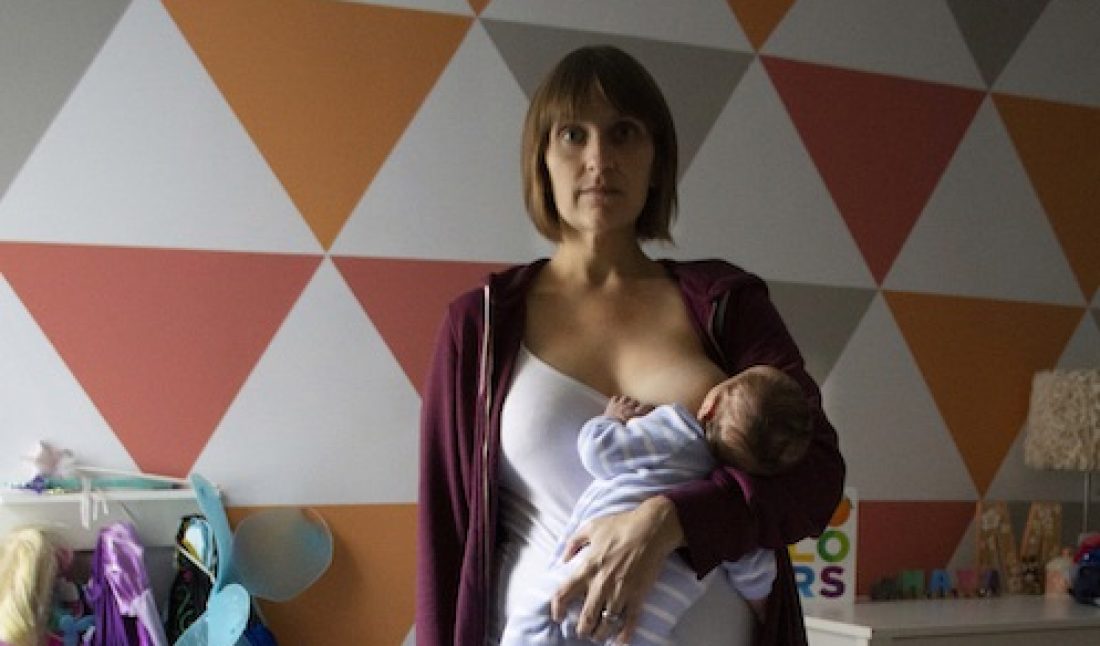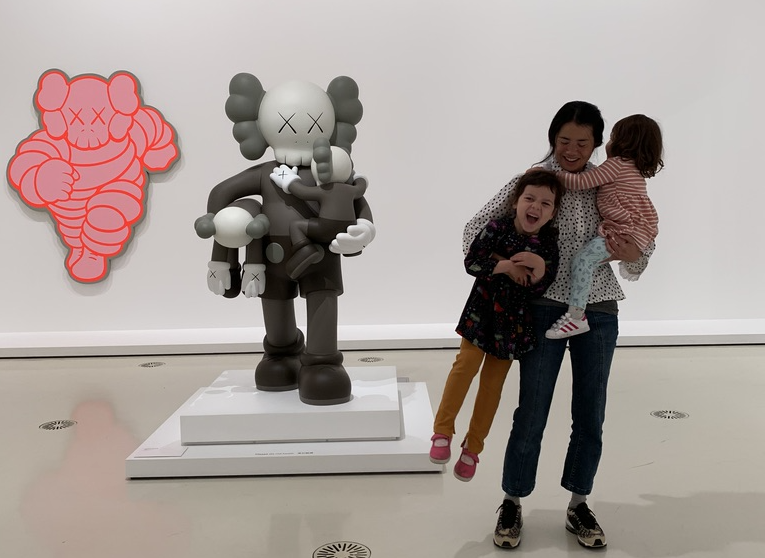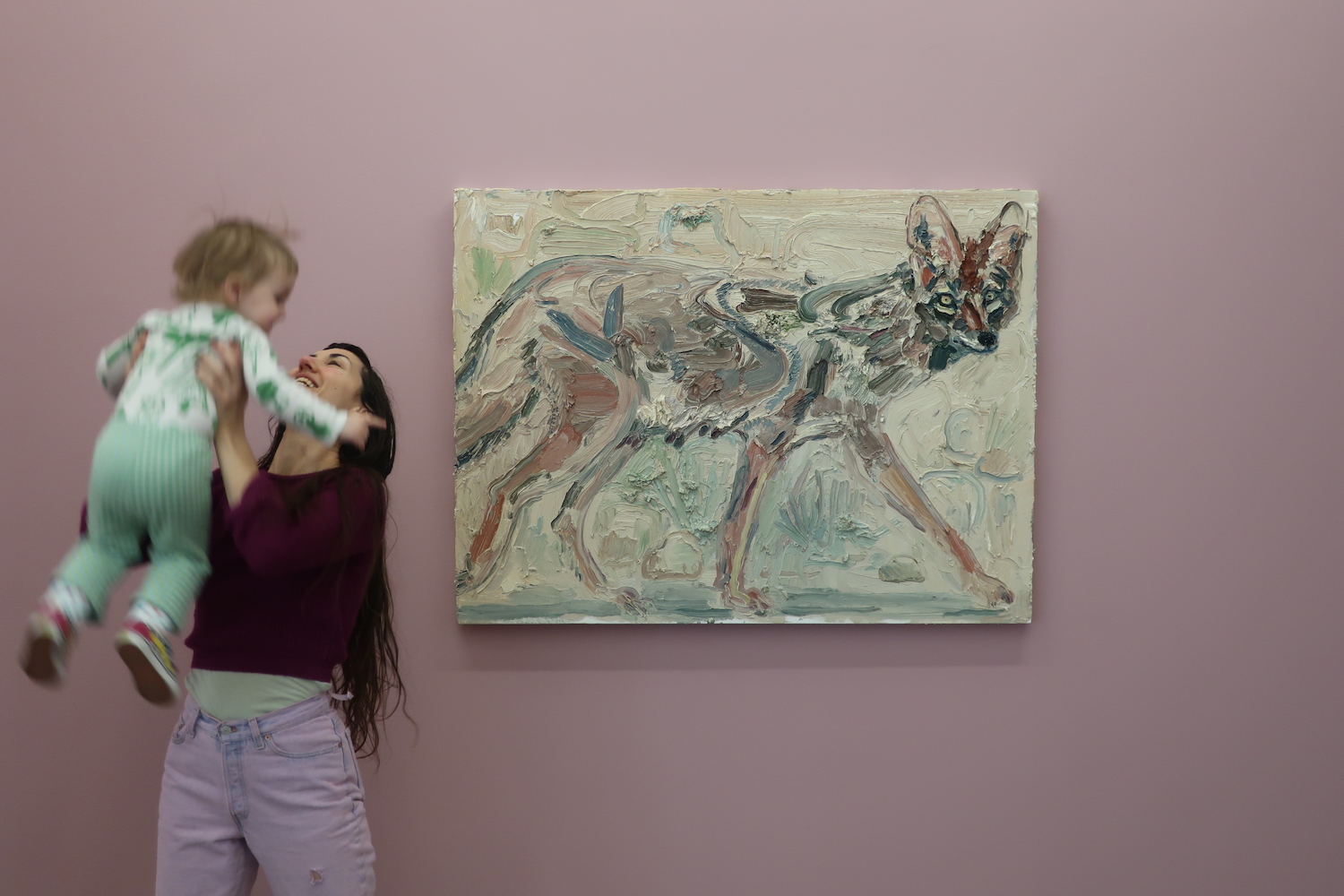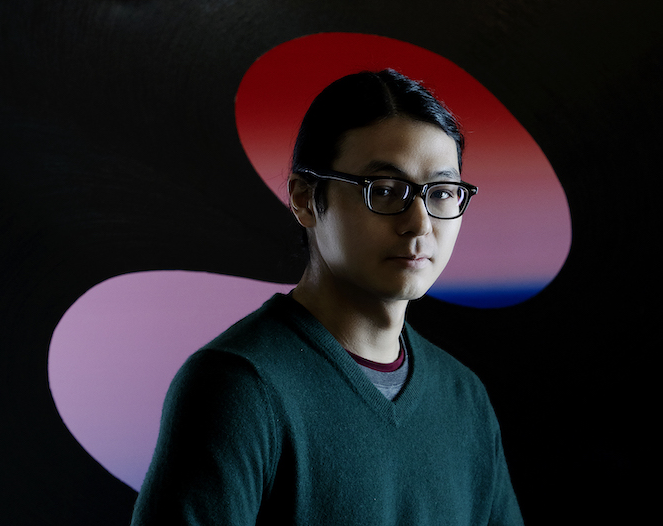Aimee Gilmore’s art has always been rooted in personal narrative. So, when she found herself embarking on an MFA program at the University of Pennsylvania in the fall of 2015 with her three-month-old daughter Maya, it was only natural that her work began to reflect her awesome transition into motherhood.
Gilmore recently participated in the “Feminist in Residence” program at Project for Empty Space in Newark, where she created a series connecting the violence and beauty found in birth stories and lullabies. A piece from her ongoing “Milkscapes”—a series of abstract landscapes made from breastmilk on fabric, paper, and other materials—is currently on view at Richard Saltoun in London, in the group show “Maternality” (up through February 15).
Whitewall visited Gilmore in her Philadelphia studio late last year, where we discussed how her practice investigates the stereotypes, tropes, pressures, and expectations placed on motherhood. We learned that while in grad school, that work was met with great criticism, diminished into the realm of the sentimental and not serious. She was told to not worry, that she would get over it and make great art soon enough.
It is perhaps for this reason why Gilmore’s aim now is to share and make space for as many voices as possible in her art. And why we so enjoyed speaking with her for this latest “Art Mamas” conversation.
WHITEWALL: When did you become a mother?
AIMEE GILMORE: I had Maya in May of 2015. And in August of 2015 I started an MFA program.
WW: You’re kidding!
AG: It was my first time so, of course, naively, I kept telling myself, “This will be fine! I can totally do this! I can go to school full time!” I knew graduate school would be transformative and demanding. But what I wasn’t prepared for was the fourth trimester overlapping with my first semester of school. Looking back, I was still in shock both physically and emotionally and not yet fully awakened to the intensity of motherhood.
My work had always been rooted in personal narrative, so it felt like a natural progression for me to now bring this transition into motherhood into my studio. Also, I really had no choice. I needed to be in the studio, and I needed to be with Maya. I had to try to exist in both worlds. Whether I was pumping in my studio or wearing her around the studio, there wasn’t a moment when she wasn’t with me literally or figuratively.
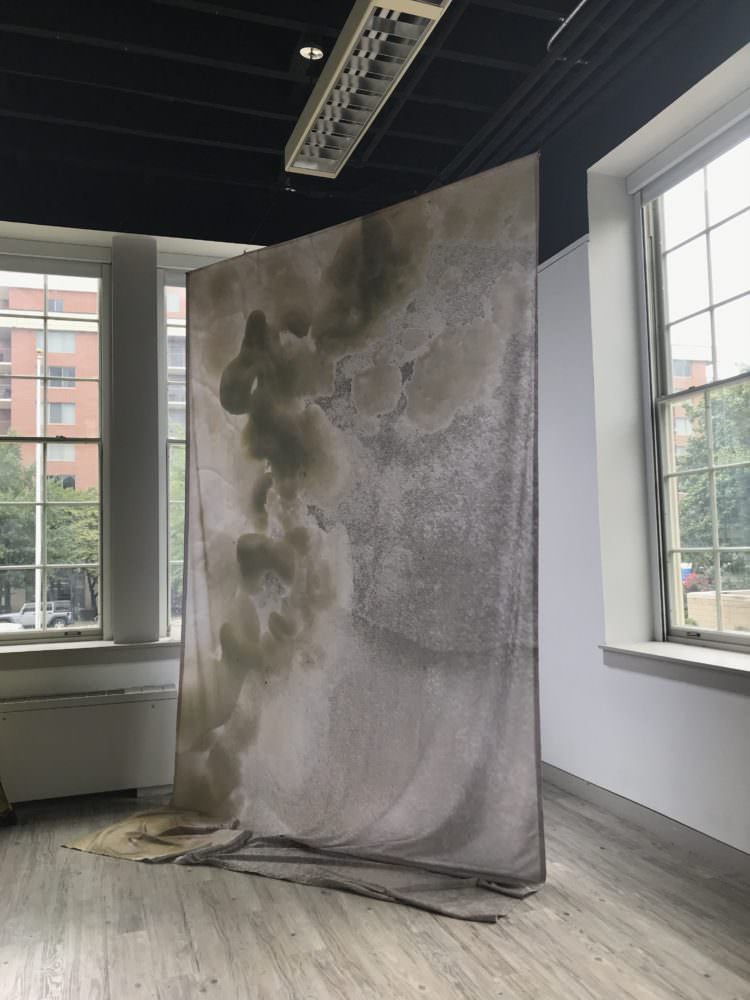 Aimee Gilmore
Aimee GilmoreMilkscape (column)
Courtesy of Aimee Gilmore.
WW: I can imagine! What was that transition like?
AG: When I think back to those first few months of school, it’s actually shocking I made any work at all. My body was still recovering. I was still struggling with nursing, staying up all night literally just watching her. To make work through the fog of those late nights was really taxing, although at the time, I didn’t allow myself to feel overwhelmed. I guess I was scared to even question if I had made the right choice.
WW: There’s this shame that comes from going back to work, wanting to pretend like you’re the same you. I’ve found that it’s already internalized for me. I’m in a completely supportive professional situation, but somehow, I find myself worrying if I have to explain that I need to move a call to nurse or go to an appointment.
AG: Totally! And the design advancements of products for new mothers, like the breast pump, are really this false freedom to get back to work as soon as possible. It creates this dynamic of extreme pressure to do it all.
WW: Right! You can go back to work because now you can pump!
AG: Yes! There’s this weird demand to return to your pre-baby life as soon as possible, which of course can never happen because now you have a baby! There is an insanely unfair amount of pressure and judgement put on mother’s about every single decision they make, like feeding their baby, and unfortunately the decision is not always one they want to make but one they have to make.
WW: Did you find your program supportive?
AG: Actually, I felt quite the opposite. Right away, I felt like I had to hide that part of my life to be taken seriously as both an artist and student. I always felt like I had to tip toe around the fact that I wasn’t there because motherhood was calling. I found myself making excuses that didn’t include being a mother for why I couldn’t go. I hate that I had to feel that way.
WW: How did that impact what you were making?
AG: I started making this work because I felt an undeniable need to share my experience. I was so consumed by and obsessed with what happened to my body and the power that came with having experienced labor and birth. I felt all of the clichés and stereotypes. I felt reborn, I felt energized, I felt totally devoured by the softness of her skin against mine. I had never felt more confident.
There are these tropes that are so dismissive to the labor of what being a mother actually entails and the broadly characterized way the role is often portrayed. The reality, of course, is that the role is extremely complex and nuanced, which is a hard lesson to learn. I was trying to work through this and find the significance in theses stereotypes and how they were influencing how I was becoming a mother.
I also felt totally unprepared and totally overwhelmed. I was trying to make sense of it all in any way I could through my artwork. And then at my most vulnerable, I was getting shut down over and over.
WW: How so?
AG: Well, the overwhelming response to this work was that what I was doing was “mom art” (whatever that means), not serious “art-world art.” I was generating work from an emotional response, not some theoretical text, and that made it unsophisticated. Somehow, being sentimental and serious were presented as binaries. I’ll never forget one of my professors told me, “Don’t worry, you’re a good artist you’ll be interested in other things soon.”
WW: Wow.
AG: One of the pieces that I decided to show for a critique was a series of self-portraits where I took selfies on my phone while I was nursing Maya. Then I paired each photograph with a text work that quoted some of the negative things that were being said to me in response to my work. The conversation exploded because the first professor to talk said it was deeply narcissistic. It was at that very moment that I realized how ludicrous it was that the idea of motherhood would be considered such a taboo topic for artwork. What could be more universal?
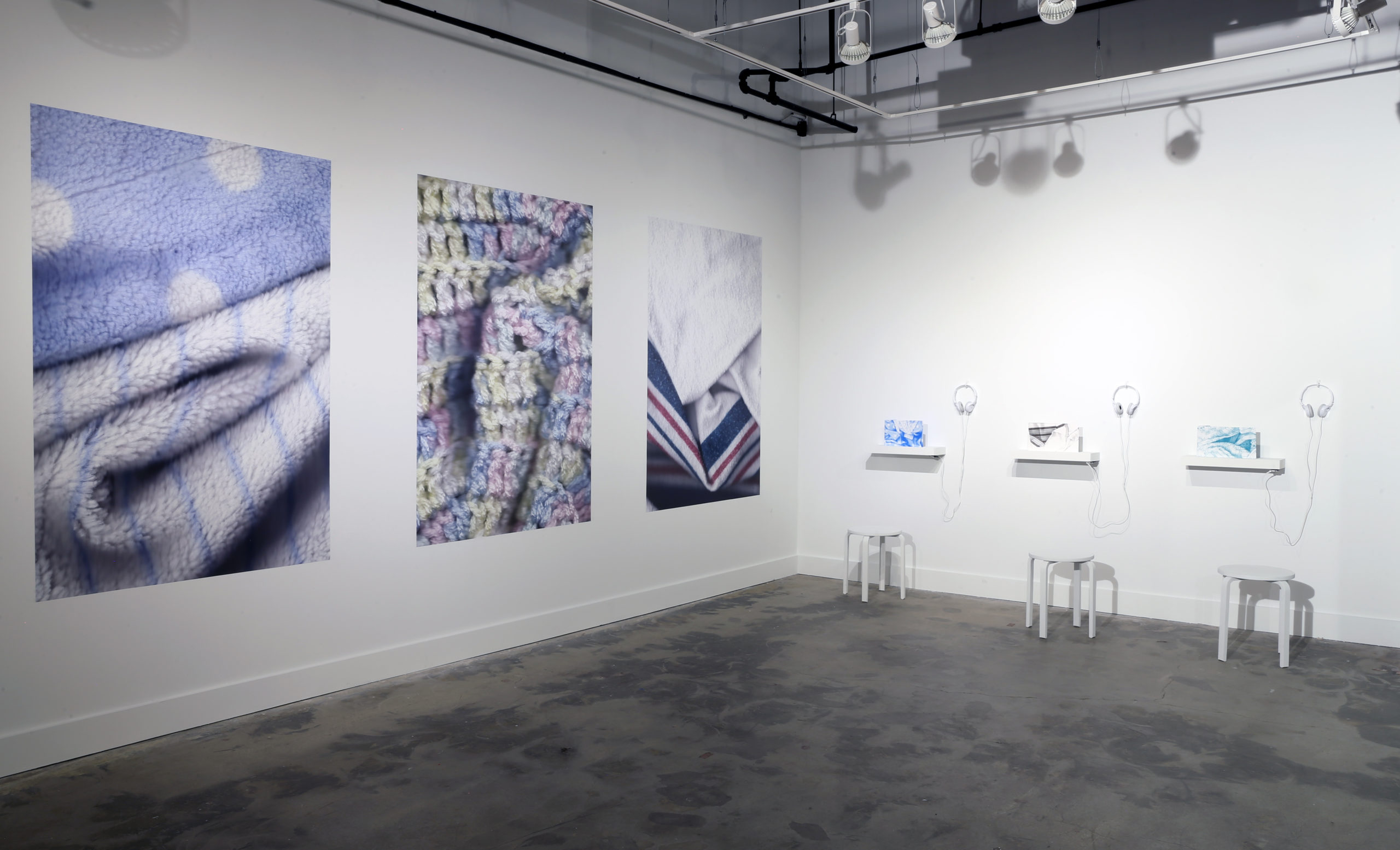 Installation view of Aimee Gilmore at Project for Empty Space.
Installation view of Aimee Gilmore at Project for Empty Space.
WW: This is in 2015? That’s so bizarre to me, given that work exploring identity is nothing new.
AG: My classmates were totally supportive. But I still felt really deflated. And then I started uncovering all of these artists that have been making work about motherhood for years and years.
WW: Who were some of the artists that you did find – whether currently or in the past – making work about motherhood?
AG: Janine Antoni has always been an artist I really loved and have been inspired by. Her work is not necessarily specifically about motherhood but it alludes to the journey as she’s using her postpartum body in a very primal way as a tool. I had the opportunity to work with her in her studio, during my undergrad studies, and her daughter was there was running around, her husband was next door. There was no separation between mother-artist-partner, no hiding those aspects of her life. She was owning it. It was a part of her studio life, her work, it was everywhere, and it was so natural and so lovely. That has really stayed with me even before I was a mother myself.
And, of course, Mary Kelly, Louise Bourgeois, Catherine Opie, Renee Cox, Cathy Wilkes, Carmen Winant…
Mother Reader changed everything for me. It’s a beautiful collection of essays that stresses the significance of our journey as mothers. Reading that gave me the support that I was formally seeking from my professors. It reminded me to follow my own truth. I’m not ashamed of it and I don’t feel that it’s demeaning to my intelligence, my focus, or my dedication to other things, to be so in love with being a mother. I wanted to own that power.
For my thesis piece, I built a lactation room in the middle of the gallery. Here I was, at this world class institution, ranked #1 in all of these innovations, and I’m standing, pumping in a bathroom. There was a lactation room across the campus in the women’s center but in the art department there was nothing.
Not only was there no space in the conversation for this topic but there was also no physical space for me to exist as a mother. No schedule changes, nowhere for me to pump, my studio didn’t have a door. Every step along the way there was no space to hold this conversation anywhere. So, I built a lactation room in the middle of the gallery.
WW: I feel like when male artists talk about how their work has been changed by becoming a father, we applaud it. But if a woman said the same thing, it’s seen as sentimental or quaint. Or a male artist can make work with semen and it’s subversive and brilliant, but if you make work with breastmilk, you’re the narcissist?
AG: Exactly! The next series I started happened by accident. I was pumping in my studio. I had to leave, I was in a rush, and I spilled breast milk everywhere. I didn’t have time to clean it up, so I just ran out.
The next day I came in and it was all over all of these things on my desk, including a sheet of mylar. I picked it up to throw it away, it hit the light, and I thought “This is gorgeous!” Overnight the milk curdled and cracked all while building a collection of organic forms that retained the appearance of a purposeful mark. I saw my that breast milk performed as the material trace of my transition into my new role as mother—beautiful but messy, quiet and calm yet chaotic and unpredictable, and profoundly abstract while similarly rooted in reality. Produced for her. Only for her. Only from me.
I started to think about how my breast milk was performing as the invisible ink of a secret dialogue between mother and child, only revealing its materialness when separated from the body. It is an element of the earth, of nature, of my body.
The images reminded me so much a satellite image of terrains that I decided to start calling them “Milkscapes.” They reflect the process of archiving a routine through its most essential material and highlight the communication between mother and daughter through abstraction. For me this series embodied that I could viscerally suggest the abstract nature of motherhood, using the unpredictable nature of breast milk as a material exposes and emphasizes the necessity of letting go.
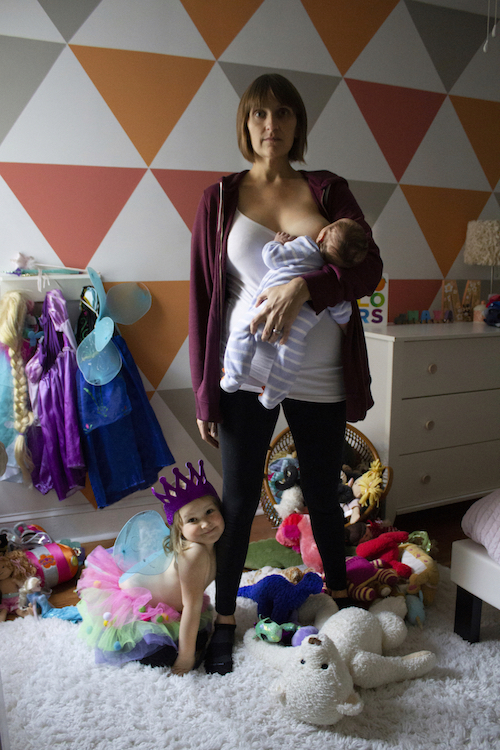 Aimee Gilmore with Max and Maya.
Aimee Gilmore with Max and Maya.
WW: After such a negative reaction in grad school, what kept you going?
AG: I had to. I really felt—and still feel—consumed by motherhood both in all its glory and its hardships and I think I am trying to make sense of it all and also acknowledge and honor it through making.
I have never been so aware of the concept of time before motherhood. I see my work as a way to try and hold tight to this fleeting time of new motherhood, allowing myself to obsess over their smallness and all the little tiny socks. I feel an undeniable need to speak these truths that often go overheard and ignored and often dismissed. I see my voice and potential platform as an artist as an extreme privilege.
I recently had an amazing opportunity at Project for Empty Space. I applied and got accepted into their Feminist in Residency program when my second child Max was three months old.
WW: I’m seeing a trend [laughs]. I cannot be more in awe of you for taking on such challenges just after the fourth trimester! I feel like I’m still just emerging from my postpartum fog.
Tell me about the residency.
AG: At the very first meeting I had to bring Max, he was so young and I had to nurse him. I remember anxiously walking in wearing Max and right away Jasmine Wahi and Rebecca Jampol were admiring his cuteness and wanting to hold him. I was like, “Yes, okay!” This is what a supportive community is like!
It definitely helped that Rebecca had just become a new mom herself so her darling little one was in the mix and we were able to support each other through our shared experience of trying to navigate motherhood. I never felt more validated and more seen and heard. They were behind me every step along the way, supporting not only my project but me as a mother, giving me the space to share my experience and talk about motherhood in all its complexities.
There’s an undeniable power that happens when a group of badass women come together all working towards a common goal. I realized how much I needed a truly supportive community to thrive.
WW: And what are you creating now?
AG: I’ve been continuing the “Milkscapes” series since having Max. They exist in a lot of different forms—photographs, large-scale banners, prints on paper, on fabrics, as small books.
I’ve been thinking a lot about the stress and pressures of fertility on women. How difficult it is for so many women in so many different ways. I’ve been researching fertility shrines and imagining what a contemporary take on a very “American” shrine to fertility might look like today? So, I’ve been making small banners out of ovulation strips, chrome-plating pregnancy tests, making amulets in the form of jewelry made from beads that are solidified breast milk, making paper out of discarded baby clothes. I like to work on multiple things at a time so I can be working on one piece while another is drying, etc.
I also started a work called “The Lullaby Project.” After Maya was born, I wanted to share my birth story with every single person. All of the beautiful and gory details. And I started becoming really interested in hearing collecting other birth stories.
WW: I’m always waiting for people to ask me mine! Which is funny because I didn’t want to read birth stories when I was pregnant. I think I was afraid and also didn’t want to set any expectations because I knew birth was out of my control for the most part. But I loved my labor! I did all things I wasn’t “supposed” to do. I ended up getting induced, had an epidural, and an episiotomy—all things I was warned against. But I had a great experience. I liked the care I got at my hospital.
AG: The impetus for the project was meeting an incredible woman named Mary Baxter. As we got to know each other I learned that she had given birth in a detention center here in Philadelphia. She was incarcerated while pregnant and prematurely went into labor from the stress. She wasn’t taken to a hospital. She was forced to labor and deliver her baby shackled to a bed. At the time, Pennsylvania still had no regulations outlawing women being shackled during birth while incarcerated. It is so utterly inhumane and horrific.
After hearing Mary’s story, I felt compelled to hear more. Other mothers that I reached out to were so gracious in sharing their stories. I think these birth stories highlight the raw strength and power that’s activated from within to get through labor, adding nuance to shift the archetype of mother. Each story is transformed into its own lullaby.
Simultaneously I started researching the origin of lullabies and found that they originate form these really horrific and violent stories that were somehow transformed into melodic beautiful songs, sung to protect newborn babies from an evil spirit. I liked that parallel between lullabies and the way birth is presented in a very sterilized way hiding the violent, messy reality of it all.
WW: You told us about bringing both Maya and Max into your studio. How do you continue to share in art with your children?
AG: It’s really important that I bring both Maya and Max here to the studio. So, this space behind you is Maya’s working space. She loves to come here with me. We work her together but on our own things. Her drawings are up, too. A lot of what I talk about in my work is about sharing space and making room for many narratives and voices so I think about that in terms of my kids, too. Right now, it’s a little harder to get anything done with Max here at the moment, but it’s still important for me to bring him even if we just sit and play together. Ideas are still being generated just by observing them and sharing this space together. Maya loves coming here, although it could also be the secret candy stash she’s discovered [laughs].
This work wouldn’t exist without them and I want them to know that and really feel that first-hand. I tell Maya all the time, “You made me a mother.”






